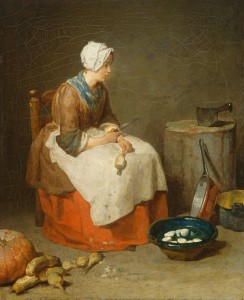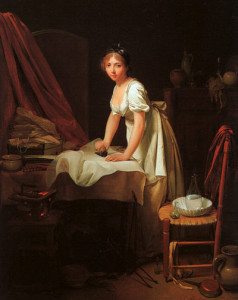
Servants were an indispensable part of running any Big House throughout the ages, including those in existence in Regency England. Manor houses and castles where the upper classes lived were huge and required an army of servants to keep them clean and well-maintained. Also, the owners themselves required a great deal of help from their staff. According to The Victorian Domestic Servant, the Duke of Bedford had 300 servants in his employ, and the Duke of Portland employed 320. To be sure, not all Big Houses had quite so many, and upper class people who lived in more modest houses employed far fewer servants. However, all seemed to have servants.
In Jane Austen’s Sense and Sensibility, the Dashwood ladies had to count every penny once they were removed from their home, but they still had two servants to help them while they lived in their humble cottage. The care of clothing alone, not to mention cooking or cleaning, was a major undertaking in those days, and gently bred ladies certainly would have lacked those skills. Even members of the gentry who considered themselves poor probably had at least a maid of all work who did everything–cleaning fireplaces, laundry, dishes, dusting, sweeping, scrubbing floors, etc. and was still expected to wait on the ladies in the home. Single gentlemen who lived alone in their bachelor’s rooms had at least one male equivalent of a maid of all work, often referred to as a valet (though his tasks would have been more varied than if he were a valet for a lord in a Big House). This all-around male servant was often simply referred to as a “boy” or a “man.”
Servants’ duties mostly took place out of sight. It was good form for a servant to be silent and invisible, which is why so many houses have secret passageways–they were usually servants’ stairways and corridors. Servants arose hours before their masters and worked late into the night. They were also at the mercy of their employers and were called upon to work in any kind of weather, at any hour of the day, with few personal days off, and often had poor accommodations.
 Classes existed in the world of servants from the top which included the head butler, head housekeeper, and chef, right down the to very bottom to the scullery maid. They all knew where they fit in that hierarchy, just as businesses have a hierarchy from the president down to the janitor.
Classes existed in the world of servants from the top which included the head butler, head housekeeper, and chef, right down the to very bottom to the scullery maid. They all knew where they fit in that hierarchy, just as businesses have a hierarchy from the president down to the janitor.
Ladies’ maids were high on that ladder, often dressed well and had only to serve their lady’s personal needs, dress her, and style her hair. In some houses, the lady’s maid was also charged with caring for her lady’s clothing, but most houses sent the laundry out to a laundress.
The footman was also a coveted position. His main role was to be young and handsome, wear livery (a costly uniform), and open doors as well as run the occasional errand such as carrying his lady’s packages on a shopping expedition. He was also expected to serve guests during a dinner party or ball–everything from fetching hats and wraps to bringing drinks and serving dishes at dinner.
Most servants were unmarried. Employers didn’t want servants distracted by spouses or children. Since servants must be at their lord and lady’s beck and call, they slept in the servants’ quarters, usually in the upper floors or attic, or on a pallet in the kitchen floor, and could be dragged out of bed without a second thought if their lord had need of them. Essentially, servants were married to their jobs. Some male house servants married, but they had very few days off a month when they could go home. Outdoor servants, however, such as stable hands, gardeners, and gamekeepers usually stayed in their own little cottages somewhere on the grounds. It was fairly common for these servants to be married and have families.
Female servants who wanted to marry did so with the understanding that their position in the house was forfeit. Occasionally, the head housekeeper and butler were a couple, but she only joined the staff after her children were raised.
A servant’s pay was meager, the hours long, and the work often back-breaking, but there was never a shortage of applicants–after all, house servants had a place to sleep and regular meals, not something they could obtain from most other jobs such as those in a factory. In addition, their tasks usually had little to no risk of danger, also unlike factory jobs.
I admit, having a cook and maid-of-allwork sounds very appealing, doesn’t it?
For further reading, I recommend:
The Victorian Domestic Servant by Trevor May
http://www.susannaives.com/nancyregencyresearcher/
https://janeaustensworld.wordpress.com/tag/regency-servants/
http://rth.org.uk/regency-period/family-life/servants
Novels told from a servants’ point of view which are well-written and carefully researched are:
Longbourn by Jo Baker
Maid to Match by Deeanne Gist
